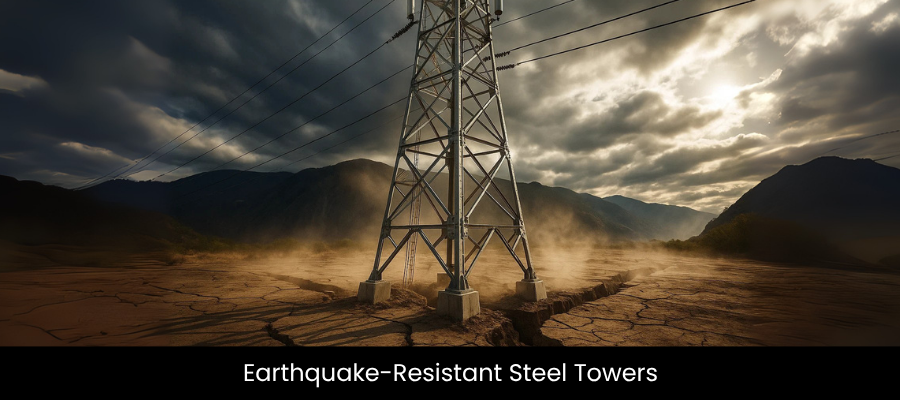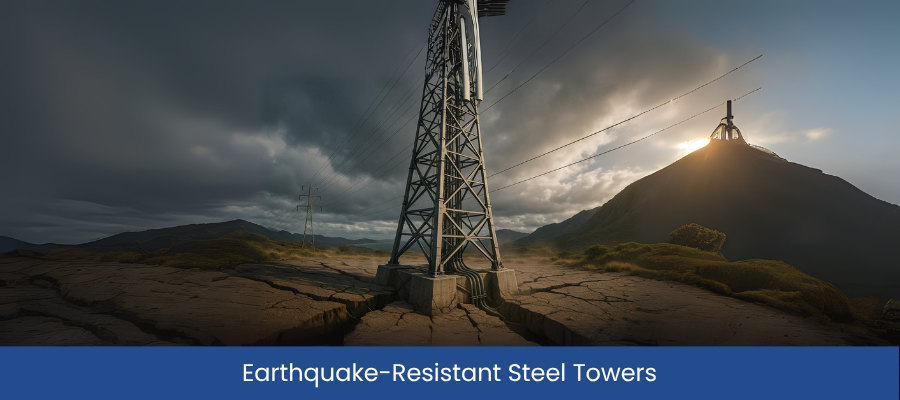Designing Earthquake-Resistant Steel Towers for Communication and Power

What Are Steel Towers and Why Are They Critical for Communication and Power?
Steel towers are preferred due to:
- Strength: Steel’s high tensile strength allows for the construction of tall, sturdy towers that can support heavy loads like antennas, cables and other equipment.
- Flexibility: Steel provides the necessary flexibility to absorb seismic forces while maintaining the structural integrity of the tower.
- Durability: Steel is resistant to the wear and tear caused by weather conditions, corrosion and other environmental factors, making it ideal for outdoor infrastructure.
How to Design Earthquake-Resistant Steel Towers
1. Structural Design and Material Selection
The design of the tower itself plays a pivotal role in its ability to withstand seismic forces. A well-designed steel tower can absorb and distribute seismic energy, preventing failure during an earthquake.
- Steel Material Properties: Selecting the right type of steel is crucial. High-strength steel alloys with good ductility (ability to deform without fracturing) are ideal for earthquake-resistant towers. These materials can absorb seismic energy without breaking, ensuring that the tower remains intact during an earthquake.
- Tower Geometry: The design of the tower, including the shape and height, impacts its ability to resist seismic loads. For earthquake-prone areas, engineers often design towers with a wider base and tapered top to improve stability. Additionally, the use of bracing systems, such as diagonal braces or X-bracing, can help distribute seismic forces evenly.
2. Seismic Bracing and Dampening Systems
Bracing and damping systems are vital for improving the stability of steel towers in earthquake conditions. These systems work by reducing the amount of movement a tower experiences during seismic events.
- Bracing Systems: Bracing systems are designed to add extra lateral support to the tower. These braces help to prevent the tower from swaying too much during an earthquake. Common bracing techniques include cross-bracing and diagonal bracing, which create triangular configurations that can resist lateral forces.
- Dampers: Earthquake dampers are devices that absorb the energy produced by seismic forces. They can be installed at various points in the tower to reduce sway and vibration. These dampers can help dissipate the energy before it reaches the tower’s critical components, preventing structural damage.
3. Foundation Design
The foundation of a steel tower structure is crucial in ensuring its earthquake resistance. A solid foundation can prevent the tower from tipping over or sinking into the ground during an earthquake.
- Deep Foundations: In areas with loose or soft soil, deep foundations, such as piles or caissons, are often used. These foundations extend deep into the earth, providing a solid base for the tower to stand on. This ensures the tower remains stable, even during strong seismic events.
- Soil-Structure Interaction: Engineers must also consider how the soil interacts with the structure during seismic activity. The dynamic behavior of the soil can influence how seismic forces are transmitted to the tower. Proper analysis of the soil conditions at the tower site is essential for designing the foundation and ensuring stability during an earthquake.
4. Load Distribution and Dynamic Analysis
During an earthquake, seismic forces are dynamic and constantly changing. To ensure that communication towers and power transmission towers remain stable, it is essential to conduct dynamic analysis to predict how forces will be distributed throughout the tower.
- Dynamic Load Analysis: Engineers perform dynamic load analysis to understand how the tower will respond to seismic activity. This involves studying the natural frequency of the tower and comparing it with the frequency of the seismic waves. If the two frequencies match, resonance can occur, amplifying the seismic forces. In such cases, adjustments to the tower design, such as altering the height or stiffness, may be necessary to avoid resonance.
- Load Distribution: Steel towers must be designed to distribute loads evenly throughout the structure. Ensuring that seismic forces are spread across multiple support points helps minimize stress on individual components, preventing damage and improving overall stability.
When Are Earthquake-Resistant Steel Towers Most Needed?
Steel towers for communication and power transmission are especially crucial in seismic regions. These regions, which experience frequent earthquakes or aftershocks, require towers that can withstand seismic forces and continue functioning without disruption.
- Seismic Zones: Towers located in high seismic risk zones, such as regions along tectonic plate boundaries, need to be specifically designed to resist seismic forces. These regions are more prone to powerful earthquakes, making it essential to implement earthquake-resistant designs for all critical infrastructure, including communication towers and power lines.
- Urban and Industrial Areas: Communication and power systems in densely populated areas must be designed with earthquake resistance in mind to ensure that service is not interrupted during seismic events. For example, in cities like San Francisco or Tokyo, earthquake-resistant steel towers play a significant role in maintaining communication during and after an earthquake.

Where to Implement Earthquake-Resistant Steel Towers?
When selecting locations for steel tower structures in earthquake-prone areas, several factors must be considered, including seismic risk, foundation conditions and accessibility.
- High Seismic Zones: Towers in regions with a history of seismic activity, such as along the Ring of Fire in the Pacific Ocean, must be designed with earthquake resistance at the forefront. Locations like California, Japan and New Zealand have strict building codes that mandate the use of earthquake-resistant materials for communication and power infrastructure.
- Critical Infrastructure Sites: Steel towers for communication and power should be prioritized in locations that serve as hubs for critical infrastructure. This includes towers that support emergency communication systems, hospitals and power grids. Ensuring that these towers are earthquake-resistant ensures that vital services remain operational during an emergency.
Conclusion
Designing earthquake-resistant steel towers for communication and power transmission is essential for maintaining the integrity of critical infrastructure in seismic regions. By focusing on key factors such as structural design, material selection, bracing systems, foundation design and dynamic load analysis, engineers can ensure that these towers can withstand the forces of an earthquake without compromising their functionality.
As communication and power systems play vital roles in modern society, especially during emergencies, investing in earthquake-resistant steel tower structures is a proactive step towards ensuring the continuous flow of information and energy in seismic areas. With the right design and planning, steel towers can provide long-term stability, safety and reliability, even in the most earthquake-prone regions.
FAQs About Steel Structure Towers
Steel is the best material for designing earthquake-resistant towers due to its strength, flexibility and durability. It can absorb and dissipate seismic energy effectively, ensuring the tower remains stable during an earthquake.
Steel towers are designed with bracing systems, damping mechanisms and flexible joints that allow them to absorb and distribute seismic energy. These features help minimize structural damage during an earthquake.
Key considerations include material selection, tower geometry, foundation design, dynamic load analysis and the integration of bracing and damping systems to ensure the tower’s stability during an earthquake.
While earthquake-resistant designs may increase upfront costs due to advanced engineering and materials, the long-term benefits, such as reduced maintenance and increased safety, outweigh the initial investment.
Earthquake-resistant steel towers ensure that communication and power systems remain operational even after a seismic event, which is crucial for emergency response and maintaining vital services during and after an earthquake.

Founder & CEO
Mukesh Patel is the Founder & CEO of Build Matt ltd, specializing in Pre-Engineered Buildings (PEB) and general steel fabrication. With advanced technology, modern machinery, and a skilled workforce, he delivers efficient and high-quality solutions across East and Central Africa, including Uganda, Kenya, Tanzania, Congo, South Sudan, Rwanda, and Burundi.
- The Growing Demand for Prefabricated Walkways in Uganda’s Various Industries
- How to Ensure Safety Compliance During Rafter Steel Structure Installation?
- Fabrication Challenges in Large-Span Steel Structure Trusses and How to Overcome Them
- The Role of Guardrails, Toe Guards and Landings in Staircase Safety Compliance
- The Rise of Mezzanine Floors in Uganda’s Warehousing and Logistics Boom


